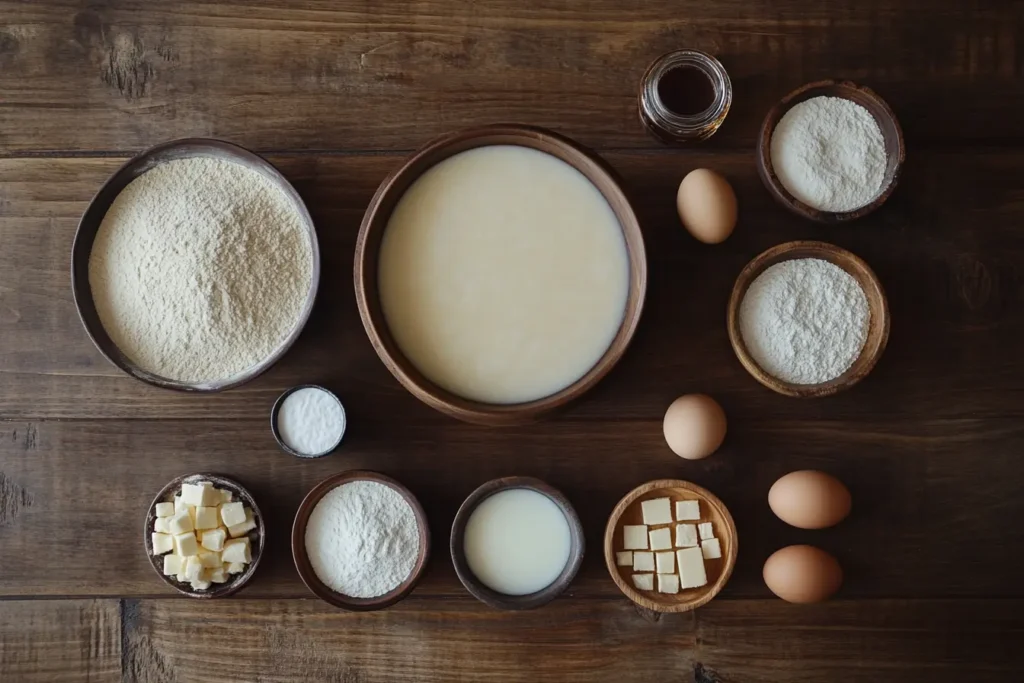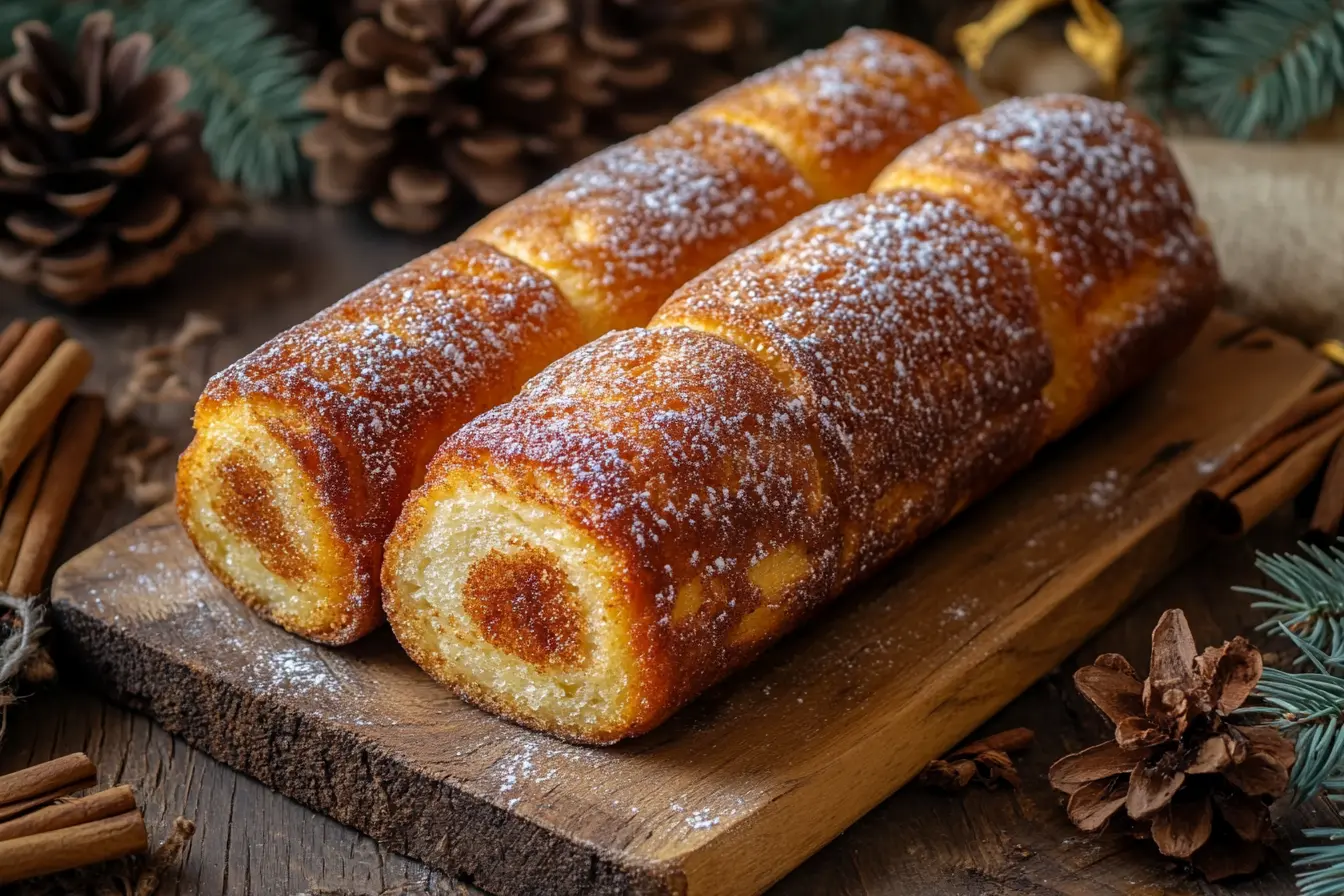Introduction
Chimney cake, also known as Kürtőskalács, is a mouthwatering traditional pastry originating from Eastern Europe. This delightful dessert, with its crispy exterior and soft, fluffy interior, is cherished worldwide for its unique preparation method and variety of flavors. But what is chimney cake made of, and how has it retained its cultural significance over the years? This article dives into the details, covering everything from its core ingredients and preparation techniques to its modern adaptations and serving traditions.
Introduction to Chimney Cake
What is Chimney Cake?
Chimney cake, often called Kürtőskalács in Hungary, is a unique pastry with a hollow, spiral shape. Bakers craft it using sweet yeast dough, wrapping the dough around a wooden spit before baking it over an open flame. The sugar coating caramelizes during baking, creating a golden crust that crackles with each bite. This crisp exterior pairs wonderfully with the soft, bread-like interior, making it a favorite treat for people of all ages.
Origin and History of Chimney Cake
This delicious dessert originated in the Hungarian-speaking regions of Transylvania during the 15th century. Communities celebrated special occasions with chimney cake, using simple ingredients to craft something truly special. The name Kürtőskalács, which means “chimney cake,” comes from the chimney-like shape of the pastry. Over time, this dessert spread across Eastern Europe, becoming a cherished tradition at fairs and festivals.
Cultural Significance in Eastern Europe
Eastern Europeans see chimney cake as more than just a treat—it’s a symbol of shared heritage. Families bond while preparing it, weaving stories and laughter into the dough. Variations like Trdelník in the Czech Republic and Slovakia show how the tradition adapted to different regions. At gatherings and celebrations, the aroma of chimney cake often fills the air, evoking nostalgia and unity.
Ingredients of Chimney Cake

Core Components of the Dough
To create the perfect chimney cake, the dough must be soft, elastic, and slightly sweet. The following ingredients form the base:
- All-purpose flour: 500g (approx. 4 cups)
- Granulated sugar: 50g (1/4 cup)
- Active dry yeast: 7g (1 packet)
- Salt: 1/2 teaspoon
- Milk (warm): 250ml (1 cup)
- Unsalted butter (melted): 50g (1/4 cup)
- Eggs: 2 large
These core components ensure a dough that rises well, tastes rich, and holds its shape during the baking process. Moreover, the proper balance between flour and liquids is crucial for achieving a flawless texture.
Role of Yeast in Leavening
Yeast plays a pivotal role in creating the light and airy structure of chimney cake. When combined with warm milk and sugar, the yeast becomes activated, starting a fermentation process. As a result, carbon dioxide is released, which forms tiny bubbles and allows the dough to rise. However, it’s important to monitor the milk’s temperature closely, as overheating it can harm the yeast, thus halting the rising process. For the best results, aim for milk that is warm but not hot—around 38–40°C (100–105°F).
Importance of Milk and Butter for Texture
Milk and butter contribute significantly to the smooth texture of chimney cake. While milk hydrates the flour, providing the dough with structure, it also adds a slight creaminess to the flavor. At the same time, butter enhances the richness of the pastry and prevents it from becoming overly dry during baking. Consequently, the final product has a tender crumb on the inside and a golden, crisp exterior.
Sweeteners: Sugar and Honey
Adding sweetness to chimney cake is essential for its signature taste. Granulated sugar not only sweetens the dough but also plays a vital role in forming the caramelized crust. Furthermore, some recipes incorporate honey to provide a natural depth of flavor and additional moisture. Together, these ingredients create a pastry that’s as pleasing to the palate as it is visually appealing.
Flavor Enhancers: Vanilla and Lemon Zest
The combination of vanilla extract and lemon zest elevates the flavor profile of chimney cake, making it distinct yet versatile. Vanilla imparts warmth and a touch of sweetness, while lemon zest introduces a refreshing, citrusy note. Together, they balance the richness of the other ingredients, ensuring every bite is full of character.
Step-by-Step Recipe: How to Make Chimney Cake
Ingredients for Coating:
- Granulated sugar: 100g (1/2 cup)
- Ground cinnamon (optional): 2 teaspoons
- Butter (melted): For brushing
Tools Needed:
- Wooden or metal baking spits (or rolling pins as substitutes)
- Baking parchment or foil
- Pastry brush
Instructions:
- Activate the Yeast:
First, combine warm milk, a teaspoon of sugar, and yeast in a small bowl. Let it sit for 5–10 minutes until it becomes frothy. This step confirms the yeast is active and ready for use. - Prepare the Dough:
In a large mixing bowl, stir together flour, sugar, and salt. Add the frothy yeast mixture, eggs, and melted butter. Next, knead the mixture until it forms a smooth, elastic dough, which should take approximately 8–10 minutes. - Let It Rise:
After kneading, cover the dough with a damp cloth or plastic wrap and leave it in a warm spot. Allow it to rise for 1–1.5 hours or until it has doubled in size. - Shape the Dough:
Roll out the risen dough into a rectangle about 1/4-inch thick. Then, use a sharp knife to cut it into long strips, roughly 1 inch wide. - Wrap the Spits:
Lightly grease the spits or rolling pins, and carefully wrap each strip of dough around them. Slightly overlap the edges of the dough as you wrap, and press the ends to seal securely. - Brush and Coat:
Using a pastry brush, generously coat the wrapped dough with melted butter. Next, roll the dough in granulated sugar or a cinnamon-sugar mixture to evenly coat it. - Bake the Chimney Cake:
Preheat your oven to 190°C (375°F). Place the prepared spits on a baking rack or use a rotisserie attachment to rotate them. Bake for 15–20 minutes, turning occasionally to achieve even caramelization. - Serve Warm:
Once baked to a golden brown, carefully slide the cake off the spit. Allow it to cool slightly, and then serve plain or topped with ground nuts, coconut flakes, or melted chocolate.
Nutritional Content
Per 100g Serving
| Nutrient | Amount |
|---|---|
| Calories | 310 kcal |
| Protein | 7g |
| Fat | 9g |
| Carbohydrates | 50g |
| Sugar | 18g |
| Fiber | 1.5g |
Traditional Preparation Methods
Preparing the Dough
Creating chimney cake begins with crafting the perfect dough, a blend of soft and slightly sweet ingredients that come together beautifully. To start, mix flour, sugar, and salt in a large mixing bowl. Separately, activate the yeast by combining it with warm milk and a pinch of sugar. Allow the mixture to sit for about 10 minutes until it becomes frothy—this indicates the yeast is active and ready.
Next, add the yeast mixture, eggs, and melted butter to the dry ingredients. Stir the mixture until it starts forming a dough. Once combined, transfer the dough to a lightly floured surface and knead it for 8–10 minutes. This step ensures elasticity and smoothness, which are essential for a successful chimney cake. If the dough feels sticky, add a small amount of flour, but avoid overloading it, as this can make the final pastry too dense.
Once kneaded, place the dough in a greased bowl, cover it with a damp cloth, and leave it to rise in a warm spot. Within an hour to an hour and a half, the dough should double in size. This step is crucial because it develops the structure needed for the cake’s signature fluffy interior.
Shaping the Dough on Spits
After the dough has risen, it’s time to shape it. Begin by rolling the dough into a large rectangle on a floured surface, about 1/4-inch thick. Using a knife or pizza cutter, slice the dough into long strips, approximately 1 inch wide.
Prepare the baking spits (or substitutes like rolling pins) by lightly greasing them with butter or oil to prevent sticking. Take one dough strip and wrap it around the spit, overlapping slightly with each turn. Press the ends of the strip to secure it in place. This wrapping technique not only creates the pastry’s iconic spiral shape but also ensures even cooking.
Once wrapped, brush the dough lightly with melted butter. For added sweetness and a crisp texture, roll the wrapped dough in a mixture of granulated sugar or cinnamon sugar. This coating caramelizes during baking, forming the golden, crunchy crust that chimney cake is famous for.
Baking Over an Open Fire
Traditionally, chimney cake is baked over an open fire, which gives it a distinct smoky aroma and crispy exterior. Wooden spits are rotated continuously over hot embers, ensuring that the dough cooks evenly. The rotating motion allows all sides of the cake to brown uniformly while the sugar coating caramelizes into a glossy, golden finish.
While open-fire baking adds authenticity, it also requires precision. Too much heat can burn the sugar coating, while too little heat might leave the dough undercooked. The baker must carefully monitor the fire, occasionally adjusting the spits to achieve optimal results.
For modern home kitchens, this process can be replicated using an oven or rotisserie. Although the smoky flavor is absent, the method produces equally delicious results. Bake the chimney cakes at 190°C (375°F) for about 15–20 minutes, turning the spits occasionally for even caramelization.
Variations and Modern Adaptations
Popular Toppings and Fillings
One of the most exciting aspects of chimney cake lies in its versatility. While the traditional recipe calls for a caramelized sugar coating, modern adaptations offer a wide array of toppings and fillings. The sugary base creates a canvas that pairs wonderfully with sweet and even savory flavors.
Popular toppings include ground cinnamon, which enhances the cake with a warm, aromatic flavor, and crushed nuts like walnuts, almonds, or hazelnuts, which add texture and nutty depth. Coconut flakes provide a tropical twist, while cocoa powder or chocolate sprinkles satisfy chocoholics.
Fillings have also become a creative addition. Chimney cakes are often hollowed out and stuffed with whipped cream, ice cream, or custard, turning them into indulgent desserts. Some variations incorporate fresh fruits like strawberries or blueberries, adding bursts of freshness to the rich pastry. These enhancements elevate chimney cake from a simple treat to a customizable delight, perfect for any occasion.
Regional Variations Across Europe
Although chimney cake is most closely associated with Hungary, it has inspired variations across Europe. In the Czech Republic and Slovakia, Trdelník is a popular street food that shares similarities with Hungarian Kürtőskalács. However, Czech versions are often coated with a thicker layer of sugar or cinnamon.
In Romania, Kürtőskalács is a festival favorite, commonly adorned with coarsely chopped nuts or colorful sprinkles. Poland features a variation called sękacz, which uses a similar dough but is cooked on a rotisserie and has a more cake-like texture.
Interestingly, some Balkan countries have their versions of chimney cake, often featuring local ingredients such as honey and poppy seeds. Despite the regional differences, the core essence of chimney cake remains consistent: a spiral-shaped pastry with a deliciously caramelized crust.
Chimney Cones and Contemporary Twists
Modern adaptations of chimney cake have taken the culinary world by storm, particularly with the introduction of chimney cones. These cones are shaped similarly to the traditional cake but are designed to hold fillings like soft-serve ice cream, creating a dessert that’s as Instagram-worthy as it is delicious.
Contemporary twists often experiment with savory flavors as well. Some bakeries offer chimney cakes filled with cream cheese, spinach, or smoked salmon, appealing to those who prefer less sweetness. Other innovations include using colorful doughs, incorporating matcha or charcoal for visual appeal, or crafting mini chimney cakes that are perfect for individual servings.
These modern takes on chimney cake have helped it transcend its Eastern European origins, making it a popular treat in trendy dessert shops around the world. Whether traditional or modern, chimney cake continues to captivate taste buds and imaginations alike.
Serving and Enjoying Chimney Cake
Traditional Ways to Serve
Chimney cake, or Kürtőskalács, is typically served fresh and warm, which enhances its delightful aroma and texture. Traditionally, the pastry is enjoyed plain, allowing the caramelized sugar crust and soft interior to shine. Many vendors roll the freshly baked cake in sugar or cinnamon sugar for extra sweetness.
In Hungary, chimney cakes are often sliced into smaller pieces, making them easy to share among friends and family. Sometimes, they are served with simple accompaniments like a dollop of whipped cream or a dusting of powdered sugar. Regardless of how it’s presented, the key to enjoying a traditional chimney cake lies in savoring its warm, freshly baked goodness.
Pairing with Beverages
Chimney cake pairs beautifully with a variety of beverages, enhancing its flavors. Hot drinks like coffee, tea, or hot chocolate complement the cake’s sweet and slightly buttery notes. The warmth of the drink also harmonizes with the soft, freshly baked texture of the cake.
For a more refreshing combination, chilled beverages like lemonade or fruit juices provide a nice contrast to the pastry’s richness. The versatility of chimney cake means it works well with almost any drink, making it a treat that can be enjoyed throughout the year, regardless of the occasion.
Chimney Cake in Festivals and Celebrations
Chimney cake holds a special place in festivals and celebrations, especially in Eastern European countries. It is a common sight at Christmas markets, where its enticing aroma fills the air and draws in crowds. During these events, chimney cakes are often decorated with festive toppings, such as red and green sprinkles or powdered sugar shaped like snowflakes.
Beyond holidays, chimney cakes are also a staple at fairs, weddings, and family gatherings. They symbolize warmth and hospitality, often served as a gesture of goodwill. With its long history and cultural significance, chimney cake continues to bring people together, creating memories that last a lifetime.
Frequently Asked Questions
What are the main ingredients in chimney cake?
Chimney cake is primarily made from flour, sugar, yeast, milk, butter, and eggs. Additional flavorings like vanilla or lemon zest can be added, and it’s often coated with sugar or other toppings before baking.
How is chimney cake traditionally cooked?
Bakers traditionally cook chimney cake by wrapping dough around a wooden spit and baking it over an open fire. As the dough rotates, the heat caramelizes the sugar coating, creating a crispy exterior while keeping the interior soft and fluffy. This method not only ensures even cooking but also delivers a delightful contrast in texture that makes chimney cake so irresistible. Furthermore, the open fire imparts a subtle smoky flavor, adding another layer of richness to the pastry.
What toppings are commonly used on chimney cake?
Cinnamon sugar, ground walnuts, coconut flakes, and cocoa powder are some of the most common toppings you can use for chimney cake. Moreover, each topping not only enhances the flavor but also adds delightful variety to the pastry. For example, cinnamon sugar provides warmth and sweetness, while ground walnuts introduce a nutty crunch. Similarly, coconut flakes offer a tropical twist, and cocoa powder brings a rich, chocolatey depth. By experimenting with these toppings, you can create endless combinations to suit any taste!
Is chimney cake the same as Trdelník?
While similar, chimney cake (Kürtőskalács) originates from Hungary, whereas Trdelník is a Czech variation. Both are made with sweet dough wrapped around a spit and baked, but they have regional differences in preparation and toppings.
Can chimney cake be made at home without special equipment?
With a bit of creativity, you can easily make chimney cake at home using everyday items. For instance, rolling pins or cans can serve as perfect substitutes for the traditional wooden spit. First, grease these alternatives lightly to ensure the dough doesn’t stick. Then, carefully wrap the dough strips around the chosen tool, overlapping slightly to maintain the signature spiral shape. Additionally, brushing the wrapped dough with melted butter and rolling it in sugar helps achieve that golden caramelized crust. Finally, bake the prepared dough in your oven, rotating it occasionally to mimic the even cooking of traditional methods. This straightforward process allows you to enjoy authentic chimney cake flavors without specialized equipment!
What occasions are chimney cakes commonly associated with?
Chimney cakes are often associated with festivals, fairs, and special celebrations, particularly in Eastern European countries. They are cherished as a symbol of togetherness and festive cheer.

